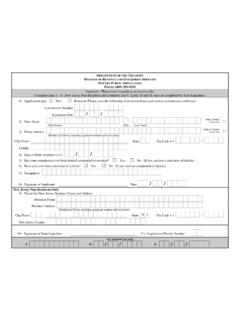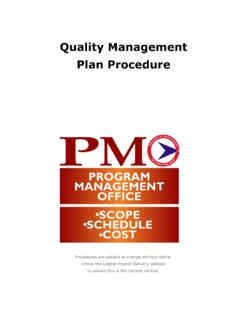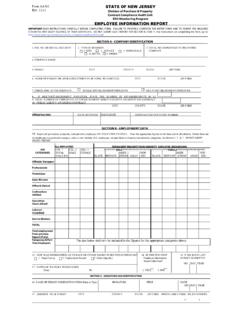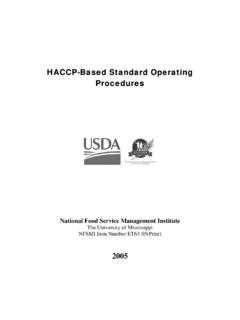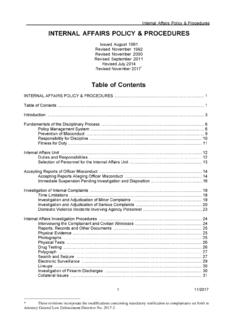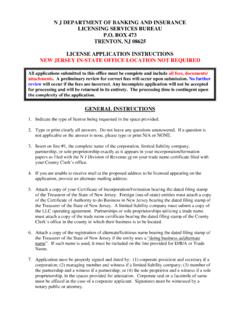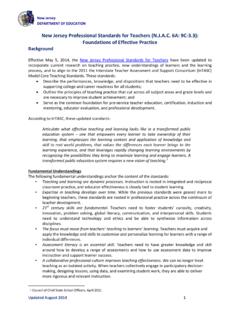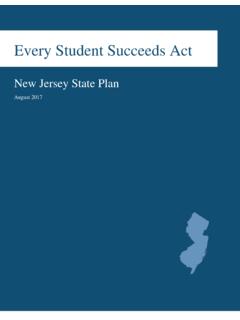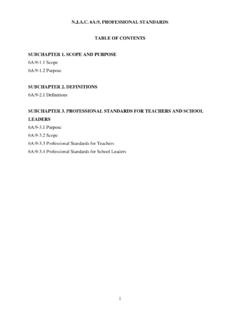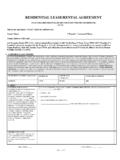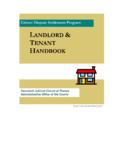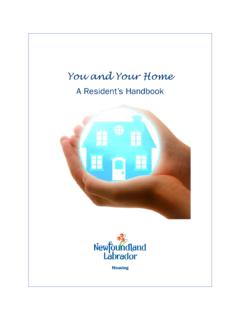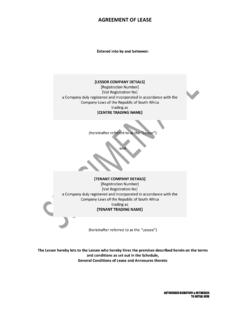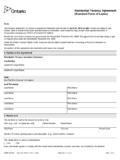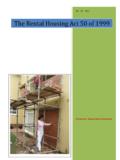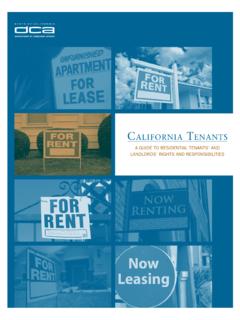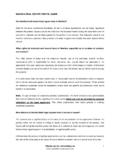Transcription of New Jersey Department of Community Affairs …
1 New Jersey Department of Community Affairs Division of Codes and Standards Landlord-Tenant Information Service habitability bulletin . Updated February 2008. This bulletin provides basic information about the responsibilities of landlords and tenants for maintaining rental units. Many citizens of the State reside in dwelling units that fail to meet minimum standards of safety and sanitation. Tenants have a right to safe, sanitary and habitable housing in New Jersey . This bulletin is for informational purposes only and should not be used for legal interpretations or legal advice. Please consult an attorney for legal services and advice when necessary. habitability Tenants have the right to safe, sanitary and decent housing. Residential leases carry an implied warranty of habitability .
2 This means that a landlord has a duty to maintain the rental unit and keep it fit for residential purposes throughout the entire term of the lease and that the landlord must repair damage to vital facilities. The tenant is responsible for maintaining and returning the property to the landlord in the same condition that the tenant received it, except for normal wear and tear. Note: Where damage has been caused by malicious or abnormal use by the tenant, the tenant is responsible for the repair. Reporting housing code violations All buildings with three or more rental units must comply with the regulations for the Maintenance of Hotels and Multiple Dwellings and must be registered with the Bureau of Housing Inspection. The Bureau of Housing Inspection is the enforcement agency for housing code violations in buildings with three or more rental units.
3 To file a complaint contact the Bureau of Housing Inspection at (609) 633-6241. Multiple dwelling units are required to be inspected every five years. One and two unit buildings do not fall under the jurisdiction of the Bureau of Housing Inspection. One and two unit buildings that are not owner-occupied must comply with any applicable local ordinances and must register with the Clerk in the municipality in which the residential property is located. No registration is required for owner occupied two family houses. When the heating equipment in a residential unit fails and the landlord does not take appropriate action after receiving proper notice from the tenant, the local board of health may act as agent for the landlord and order the repairs to fix the equipment.
4 Evictions cannot be filed unless the rental property is registered. NOTE: THE LOCAL HEALTH AGENCY IN YOUR MUNICIPALITY SHOULD BE. CALLED FOR LACK OF HEAT AND HOT WATER. LOCAL AGENCIES RESPONSIBLE. FOR HOUSING INSPECTIONS SHOULD BE CALLED FOR UNINHABITABLE. STRUCTURAL CONDITIONS. Remedies if the landlord fails to maintain the property in a habitable condition If the landlord does not keep the premises in a habitable condition, a tenant may repair any vital deficiencies and deduct the amount of the repair from the rent. The landlord's failure to maintain the property could also lead to what is called a constructive eviction by the tenant. (See below for explanation) The tenant may seek rent abatement (a reduction in rent) or withhold the rent or a portion of the rent.
5 Before applying the remedies of repair and deduct, constructive eviction, rent abatement or withholding the rent or a portion of the rent, the following must apply: 1. The defect must be of a vital facility. Vital facilities are those things necessary to make the rental unit habitable. Examples of defects to vital facilities include: broken toilets, no hot or cold water, lack of heat or electricity or broken windows. 2. The tenant must not have caused the condition. 3. The tenant must have notified the landlord that the deficient condition existed and allowed the landlord adequate time to fix the defect. Notice should be given in writing and by certified mail, return receipt requested. 1. Repair and deduct Marini v. Ireland, 56 130 authorized the self-help remedy of repair and deduct.
6 A. tenant may repair vital facilities deficiencies and deduct the amount of the repair from the rent. 2. Constructive eviction Constructive eviction means that a tenant may break the lease without penalties because the landlord is guilty of neglect or default, which makes the premises unsafe, unfit or unsuitable for occupancy. Reste Realty v. Cooper, 53 446, established the foundation for constructive eviction. If a tenant invokes the remedy of constructive eviction, and the landlord is found to be negligent in maintaining the rental unit, the tenant is entitled to the return of the security deposit and is not responsible for the rent for the balance of the lease or the cost of re- renting the property. 3. Rent abatement (reduction). Upon entering into a lease, the tenant's promise to pay rent and the landlord's warranty of habitability are dependent.
7 In Berzito v. Gambino, 63 460, the court held that a tenant claiming that the landlord did not maintain the property in a habitable condition may initiate an action to recover all or part of the deposit paid when the lease was finalized or all of the rent paid. If the court finds that the landlord did not maintain the property in a habitable condition, the tenant will be charged only with the reasonable rental value of the property in its imperfect condition during the tenancy. 4. Withholding the rent or a portion of the rent If the landlord breaches his obligation of maintaining the property at an adequate standard of habitability , a tenant may withhold the rent or a portion of the rent to be used as a set-off, because of the deficient condition. If the landlord institutes an eviction proceeding for non-payment of rent, the tenant is entitled to use the landlord's breach of his obligation to provide a habitable residence as a defense and justification for the set-off (deduction of rental payment).
8 5. Rent Receivership The law promoting safe and sanitary housing for tenants of substandard dwellings ( 2A:42-85, et seq.) was enacted after the Berzito decision. The law authorizes tenants in substandard dwelling units to deposit their rents with a court-appointed administrator for use in remedying defective conditions. If there is a difference in the market value of the premises in its defective condition and the amount of rent that the tenant paid to the court administrator, the tenant may be entitled to a rent abatement and may only be charged the reasonable rental value of the property in its imperfect condition. To use this remedy, a tenant or housing inspector may file a complaint in the court of the municipality in which the property is located.
9 In the case of Park Hill Terrace v. Glennon, Mitnick, and Stoff, 146 Super. 68, the court held that air conditioning was a part of the original tenancy and that its failure affected the habitability of the premises. Note: Not every defect or inconvenience is considered a breach of the warranty of habitability . Each case must be judged on it own facts. To avoid eviction, any rent withheld by the tenant should be saved and accessible in case the court requires the tenant to pay the outstanding rent. In emergency situations created by the landlord or resulting from his negligence, the landlord may be responsible to bear a tenant's expenses in obtaining alternative housing during the emergency. Expenses may be deducted from the rent. However, the expenses must be reasonable.
10 Utility requirements From October 1 to May 1, the rental premises shall be maintained at a temperature of at least 68. degrees Fahrenheit between the hours of 6:00 and 11:00 ; between the hours of 11:00. and 6:00 the rental premises shall be maintained at a temperature of at least 65 degrees Fahrenheit. The hot water temperature should be maintained at a minimum of 120 degrees and a maximum of a 160 degrees Fahrenheit. Utility companies are prohibited from shutting off utilities in tenant-occupied buildings whose owners have failed to make payments, without first notifying the tenant of the impending disconnection. Before disconnecting utility services, the utility company must give the tenant an opportunity to agree to make future payments. Paint requirements Interior walls, ceilings and other exposed surfaces in rental units must be kept smooth, clean, free of flaking, loose or peeling paint, plaster or paper and maintained in a sanitary condition.
